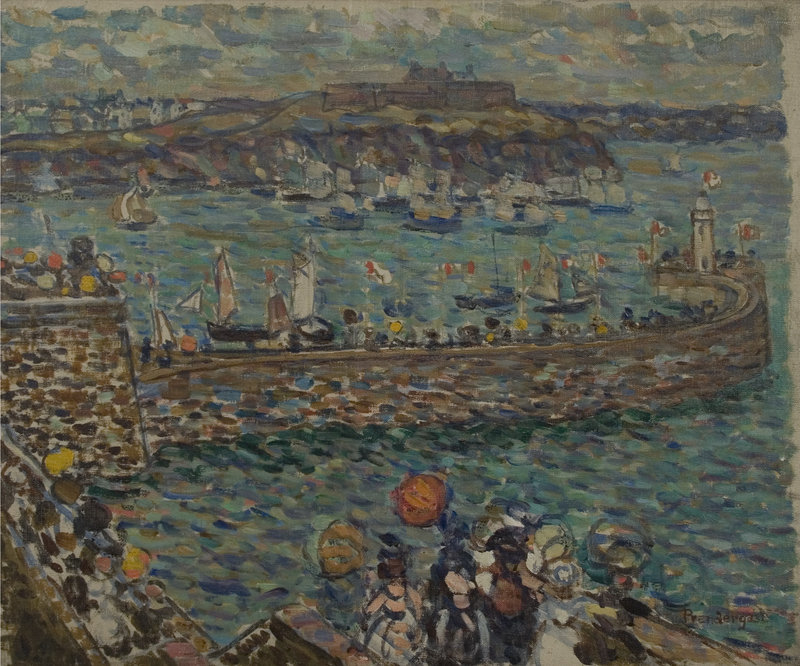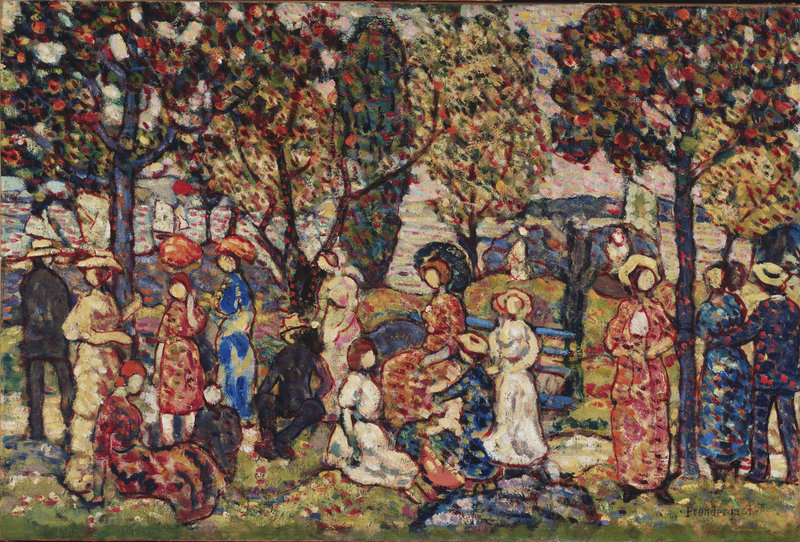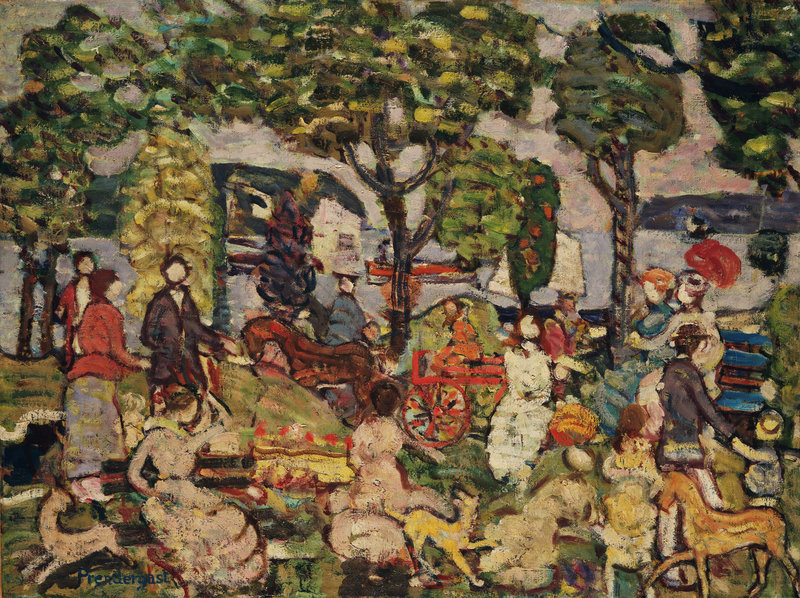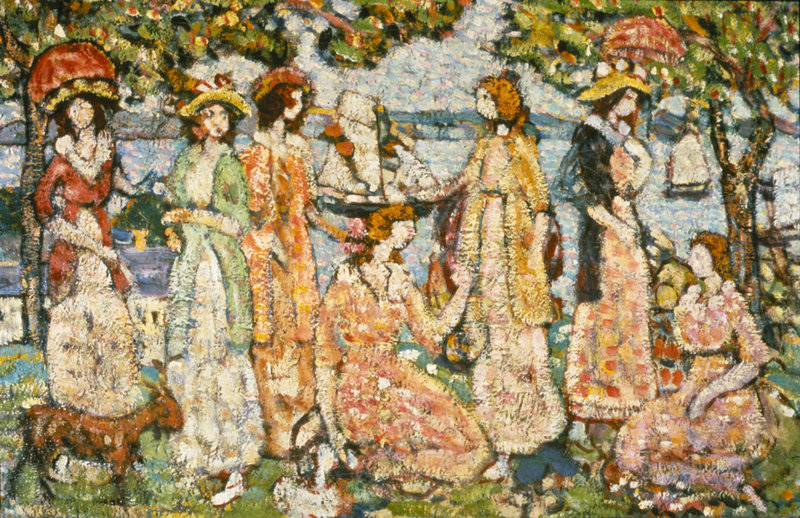The most important figure in the landmark exhibition “Maurice Prendergast: By the Sea” just might be a little goat standing by a pair of fancy ladies in Prendergast’s “The Idlers.”
The goat shifts the painting from a snapshot of early century fashionable leisure to philosophical commentary about society. Filling in for a satyr, Prendergast’s goat takes us well past the fashionably indulgent Bouguereau to the great granddaddy of smart Modernist art, Nicholas Poussin (France, 1594-1665).
Poussin’s name pops up from time to time in art texts, but fully understanding what Prendergast saw in him requires a kind of classical education that no longer exists.
Hold on. Is this the popular Prendergast — the watercolorist of charming Maine and New England beach scenes and painter of colorful Modernist bon bons?
Oh, yes.
Maurice Prendergast’s (1858-1924) work was appealing, attractive and fully engaged with decorative modes of painting, yet he was one of the most erudite and visually sophisticated American artists of the Modernist movement.
Just as you don’t have to analyze a symphony by Beethoven to enjoy it, you don’t need any explanation to appreciate Prendergast’s work at Bowdoin. Despite the erudition underneath, Prendergast’s paintings are approachable and attractive.
Analyzing Prendergast, however, reveals him to be extraordinarily ambitious in both painterly and art historical terms.
The obvious contrast is with Winslow Homer, arguably America’s greatest artist. Homer might be more profound, important and influential, but Prendergast is more erudite, philosophical, cultured and complex.
While Homer emptied his paintings of people (despite his family’s hotel a few yards behind his studio overlooking the ever-crowded Old Orchard Beach), Prendergast filled his beach scenes with vibrant figures.
Prendergast’s work is primarily painting about painting. This is why was he was sought out for the selection committees for the seminal 1913 Armory Show and by leaders like Robert Henri for exhibitions of nascent American Modernism.
Prendergast spent years studying and working in Europe. He was a colorist who understood the works of the Fauves, Matisse, the Post-Impressionists and the Van Gogh-worshipping Nabis. But he was also an artist of Boston who appears to have been fundamentally inspired by the elegant frieze-oriented figurative murals by Pierre Puvis de Chavannes installed in the Boston Public Library in the 1890s. The Symbolist Movement, of which Puvis was a heralded leader, is the easiest path to understand Prendergast’s strange-to-us-now combination of sophisticated elegance and ambitious intellectualism.
Following Puvis, Prendergast used sense to mobilize sensibility.
The first room of “By the Sea” reveals a talented young artist internalizing lessons of the day with an eye to Europe. While a watercolor of a seated couple looks to Monet, it embodies Prendergast’s struggle to assimilate abstract shapes into (an approximation of) Impressionism. Nearby, his ever-popular monotypes successfully embed the shapes in the surface — by following not Monet but the value-attenuated and flattened style of Puvis.
Prendergast locks in early on a repeated high-horizon composition looking down onto a dappled beach with numerous figures. This approach partially solves his constant struggles with a stage/backdrop structure in which the sea horizon is awkwardly conjoined with the sky. Interestingly enough, the first/early room contains the only works in the large show in which the sea comprises the entire horizon. Afterwards, Prendergast always mediates the sea horizon line with a land mass. This denies any spatial release for the eye, and while it can feel a bit claustrophobic to a Homer fan, the goal is to keep the eye in the front space that Prendergast builds on the surface of the painting.
In his mature watercolors, Prendergast holds the surface with bits of white paper dividing the strokes. In his oils, he builds up indulgently innumerable layers of impasto.
In “The Idlers,” the artist blocks any spatial release behind the seven elegantly dressed women with a pair of conveniently-placed boats.
In “Lighthouse at St. Malo” — made during the life-changing 1907 trip when he discovered Cezanne — Prendergast walks you into the scene with the flow of visitors. But as the figures break down into Impressionist marks, you leave the crowd and follow the dappled strokes of the sea against the breakwater. It’s a moment of genius.
One of the best things about “By the Sea” is the tiny room filled with works by the artist’s “allies” such as his brother Charles, William Glackens and Nabis painter Maurice Denis. Prendergast is both revealed and elevated by these comparisons.
Prendergast’s scenes of nudes on beaches may look odd to us puritanical New Englanders, but it was a common theme pursued seriously by Cezanne, Matisse, Renoir and many others. Fundamentally, Prendergast is presenting classicism — but the baroque Dionysian mode versus the sober Apollonian mode. This cuts to the core of Poussin’s dialectical vision. It is also recalls the then-ranking international art historian Heinrich Wolfflin’s 1888 book “Renaissance and Baroque” that presents art history as a pendulum swinging between the two eponymous modes echoed by sense/sensibility, enlightenment/romantic, intellectual/emotional and so on.
Prendergast, however, follows Poussin’s (literary) modes as they reach past major and minor into a full range of possibilities (imagine the set of scales starting from each white key on the piano). For example, Prendergast looks to seasonal modes with “Autumn.” In “Sunday Promenade,” he posits a weekend mode of fashion, activity, etc. And we feel the difference between nude women swimming and the fashionable figures parading on a public beach.
Prendergast’s modes comprise an extraordinarily sophisticated philosophical vision of cultural aesthetics. His was an essentially post-modern view of contemporary life as multi-faceted classicism.
Casually quick viewers might see little more than affect in Prendergast’s late works, but anyone who follows his artistic trail should find them just as brilliant as they are beautiful.
Having been misrepresented as a lightweight by recent critics concerned about their own credibility, “By the Sea” rightly re-establishes Prendergast — so widely admired by his muscular contemporaries and critics — as a major figure of the American Modernist movement. Between the handsome installation and impressive catalog, Bowdoin curator Joachim Homann deserves particular credit for pulling Prendergast studies out of the low-tide mud.
Whether you want to wrap head around the brainiest moments of Western art history or simply want to be charmed by an elegant American Impressionist, “By the Sea” is well worth a visit.
Freelance writer Daniel Kany is an art historian who lives in Cumberland. He can be contacted at:
dankany@gmail.com
Send questions/comments to the editors.






Success. Please wait for the page to reload. If the page does not reload within 5 seconds, please refresh the page.
Enter your email and password to access comments.
Hi, to comment on stories you must . This profile is in addition to your subscription and website login.
Already have a commenting profile? .
Invalid username/password.
Please check your email to confirm and complete your registration.
Only subscribers are eligible to post comments. Please subscribe or login first for digital access. Here’s why.
Use the form below to reset your password. When you've submitted your account email, we will send an email with a reset code.